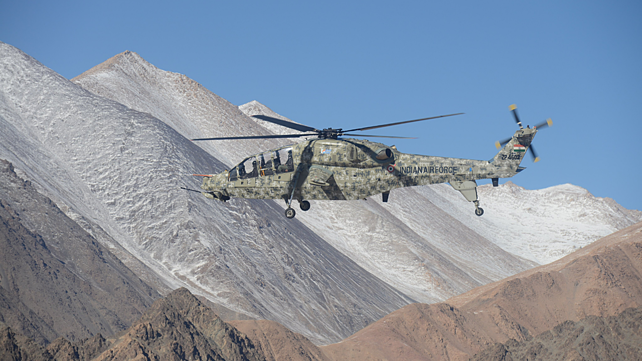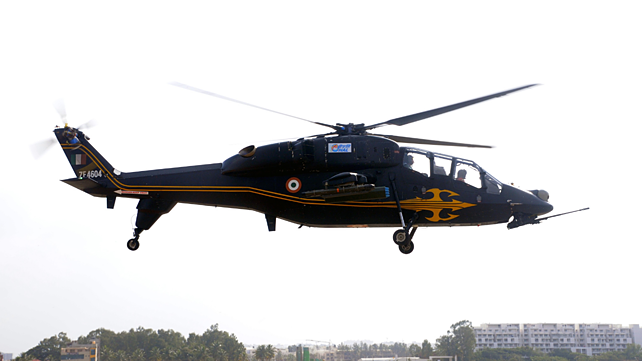
The formal handover of the first Light Combat Helicopter (LCH) to the Indian Air Force (IAF) by Prime Minister Narendra Modi at the ‘Rashtra Raksha Samparpan Parv’ in Jhansi, Uttar Pradesh last week, signifies a major milestone in the history of the Indian aviation.
Built by Hindustan Aeronautics Limited (HAL), the LCH is the first indigenously designed and developed attack helicopter to enter service with the Indian armed forces. The LCH is unique amongst attack helicopters of its class developed globally, as it is the only helicopter in the world to demonstrate its ability to land at military air bases located at the Siachen Glacier, 4,700 m (15,420 ft) above sea level with a 500 kg load.
Speaking to Mobility Outlook, Wg Cdr (retd) Unni Pillai, Chief Test Pilot (Rotary Wing), HAL said, “The LCH can carry its full weapons load till 14,000 ft, which is unmatched anywhere in the world. It is a very steady weapons platform in its dedicated attack role and fills an important gap for intercepting and engaging Unmanned Aerial Vehicles (UAV). The LCH exactly fills this slot with its speed and mix of guns and missiles.”

The 5.5 tonne LCH can attain a speed of up to 280 kmph with all external stores (weapons or sensors), and its speed and high rate of climb will make it a force multiplier for the Indian armed forces. Its high-altitude performance will allow the LCH to quickly reach the combat area and make an impact with its range of weapons and precision attack capability.
Indigenous Achievement
HAL is presently manufacturing an initial batch of 15 Limited Series Production (LSP) helicopters out of which the IAF will receive 10 and the army will get five. The LSP helicopters will allow HAL to obtain user feedback and make any changes necessary before it starts series production of the LCH. A total of 145 series production helicopters are slated to be built and at peak production capacity, HAL has plans to manufacture 30 helicopters annually. HAL has also built four prototype helicopters for the design and development programme.
The LCH is a twin-engine helicopter designed and developed by HAL’s Rotary Wing Research & Design Centre (RWRDC) to meet the need for combat helicopters that can operate at high-altitudes to meet the specific needs of the Indian armed forces.
The LCH has a high degree of commonality with the Dhruv Advanced Light Helicopter (ALH) with which it shares its ‘Shakti’ engines, avionics and internal components. HAL officials told Mobility Outlook that they have incorporated a number of stealth features and crash-worthy landing gear for better survivability. The LCH features a sleek design with both pilots being seated in a tandem-seating configuration (one behind the other) and also features armour protection for the pilots against small arms fire.

The LCH also features an Indian designed and developed glass cockpit called ‘Integrated Avionics and Display System’ (IADS) and the helicopter’s critical software has been developed by HAL’s Mission and Combat System R&D Centre (MCSRDC). The LCH is also fitted with a Helmet Mounted Sight, which is slaved to a nose mounted electro-optical pod consisting of CCD camera/Forward Looking Infra-Red (FLIR)/Laser Range Finder (LRF) and Laser Designator (LD).
As a result, the pilots just have to turn their heads towards the target, following which the sighting system will lock onto the target and await the command for missile launch. This is a particularly useful capability, against aerial threats. The LCH is also fitted with Self Protection Suite consisting of radar and laser missile warning systems and a countermeasures dispensing system to defend it against air and surface launched missiles.
Armed To The Teeth
Amongst the list of weapons that will be carried by the LCH is French defence firm MBDA’s Mistral Air to Air Missile (ATAM). The ATAM is already carried on Rudra WSI (Dhruv Mk IV) armed helicopters in service with the army and air force. The ATAM will be the LCH’s primary air-to-air missile for self-protection and also offers the additional capability of engaging moving ground targets.
“The Mistral ATAM system offers a high level of performance with unrivalled kill probability, and with its fire-and-forget functionality, it has a high ease of operation for very low crew workload,” an MBDA spokesperson told Mobility Outlook. The Infra-Red (IR) guided, high speed, fire-and-forget Mistral ATAM system comprises of two ‘twin launchers’ providing LCH with four ready to fire missiles.

The LCH will also be fitted with indigenous and foreign Anti-Tank Guided Missiles (ATGM). Each LCH will also carry four 2.75-inch (70-mm) 12-tube rocket launchers supplied by French defence firm, Thales. The rocket launchers were tested and qualified by HAL for the LCH in 2018 with orders placed in 2019. These rocket launchers are made using composite material, delivering a weight reduction of 50% as compared to traditional metal launchers.
Thales will supply these rocket launchers, along with fire control capability and its T100 sighting system. The LCH is also fitted with a powerful THL20 turret from French defence firm, Nexter Systems, which is fitted with a 20 mm M 621 cannon. The THL20 is a very light gun turret system and has an average rate of fire of 750 rounds per minute and an effective range of up to 2,000 m.